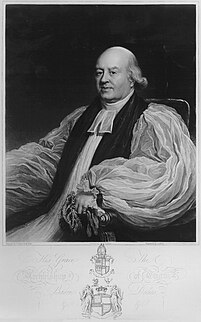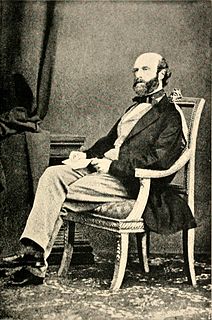Related Research Articles

Baron Decies, of Decies in the County of Waterford, is a title in the Peerage of Ireland. It was created in 1812 for the Right Reverend William Beresford, Archbishop of Tuam from 1794 to 1819. He was the third son of the Marcus Beresford, 1st Earl of Tyrone, and the younger brother of George Beresford, 1st Marquess of Waterford. His son, the second Baron, married Charlotta Philadelphia Horsley, the only daughter and heiress of Robert Horsley (1749-1809) of Bolam Hall in Northumberland, which he built on the estate purchased in 1727 by his father John Horsley. In accordance with the terms of his wife's inheritance he assumed the additional surname of Horsley in 1810. However, none of the subsequent barons have held this surname. His grandson, the fifth Baron, was a Major in the Army and also sat in the House of Lords as an Irish Representative Peer from 1912 to 1944. As of 2013 the title is held by his grandson, the seventh Baron, who succeeded his father in 1992.

Alexander Henry Haliday was an Irish entomologist. He is primarily known for his work on Hymenoptera, Diptera, and Thysanoptera, but worked on all insect orders and on many aspects of entomology.
Bryan Patrick Beirne was an Irish entomologist who emigrated to Canada in 1949. He specialized in pest management.

Eugene O'Mahony was an Irish museum curator and entomologist who worked on Coleoptera, Mallophaga and Siphonaptera.
William Maziere Brady (1825–1894) was an Irish priest, ecclesiastical historian and journalist who converted to Roman Catholicism from Anglicanism.

Monographia Chalciditum by Francis Walker, published in two volumes in 1839, was a founding work of entomology, introducing new genera of chalcidoid Hymenoptera later to be ranked as families. The work is a compilation of descriptions published in the Entomological Magazine. In its preparation Walker used descriptions provided by the Irish entomologist Alexander Henry Haliday.
Arthur Wilson Stelfox was an Irish naturalist and architect. Stelfox was a recognised authority on Hymenoptera and on non-marine Mollusca especially the genus Pisidium. He also made important contributions to scientific knowledge concerning Irish botany and on identifying and describing remains from prehistoric sites in Ireland.

Alexandre Arsène Girault was an American entomologist specializing in the study of chalcid wasps. An eccentric and controversial figure, Girault was also a prolific and dedicated entomologist. He published more than 325 papers and described over 3000 new taxa from Australia.

Frank Winder was an Irish professor of biochemistry, a naturalist, and one of Ireland's leading rock climbers in the 1950s and 1960s.

Edward Percival (Perceval) Wright FRGSI was an Irish ophthalmic surgeon, botanist and zoologist.

Joseph Ferguson Peacocke was a Church of Ireland cleric. He was the Bishop of Meath from 1894 to 1897 and then Archbishop of Dublin from 1897 until 1915. He was also briefly the professor of pastoral theology at Trinity College, Dublin.

Megastigmus is a genus of minute wasps. There are more than 134 described species, more than half of which undergo larval development within the seeds of trees and shrubs.
Born Eleanor Fisher, the first of Ernest and Janet Fisher's two daughters, in Belfast on 16 March 1908, but known even then as "Nora", Nora Fisher McMillan, as she became, was a larger-than-life self-taught expert in natural history, especially conchology, specialising in post-glacial fresh-water Mollusca, but with broad academic interests in the history of natural history, geology and other areas, as well as being a keen amateur botanist, naturalist and local historian. She wrote prolifically, with over 400 publications to her name.
Robert Francis Vere Heuston, sometimes given as R. F. V. Heuston, QC (Hon.), FBA was an Irish legal scholar and legal historian. He is best known for his Lives of the Lord Chancellors.
Zdeněk Bouček was a Czech entomologist specialising in the Chalcidoidea superfamily of the Hymenoptera. With Marcus Graham and Richard Askew, Bouček was one of the most important workers studying this large and diverse group in the second half of the Twentieth Century and these three laid the foundations of the modern systematics of the chalcid wasps.
John Stuart Noyes is a Welsh entomologist.
Karl-Johan Hedqvist was a Swedish entomologist who focused on wasps (Hymenoptera), especially chalcid wasps and other parasitoid wasps. He described 260 species and over 70 genera of wasps.

Psyllaephagus is a genus of chalcid wasps. It was named and circumscribed by William Harris Ashmead in 1900. As of 2017, Psyllaephagus contains approximately 245 species.
Margarita Dawson Stelfox ARCScI was an Irish botanist, specialising in Mycetozoa.
Marina Dmitrievna Zerova was a Ukrainian entomologist. Several insects have been named after her. She became Doctor of Biological Sciences (1980), Professor (1989) and Honored Worker of Science and Technology of Ukraine (2003). In 1981 she was awarded the Award of the National Academy of Sciences of Ukraine named after DK Zabolotny.